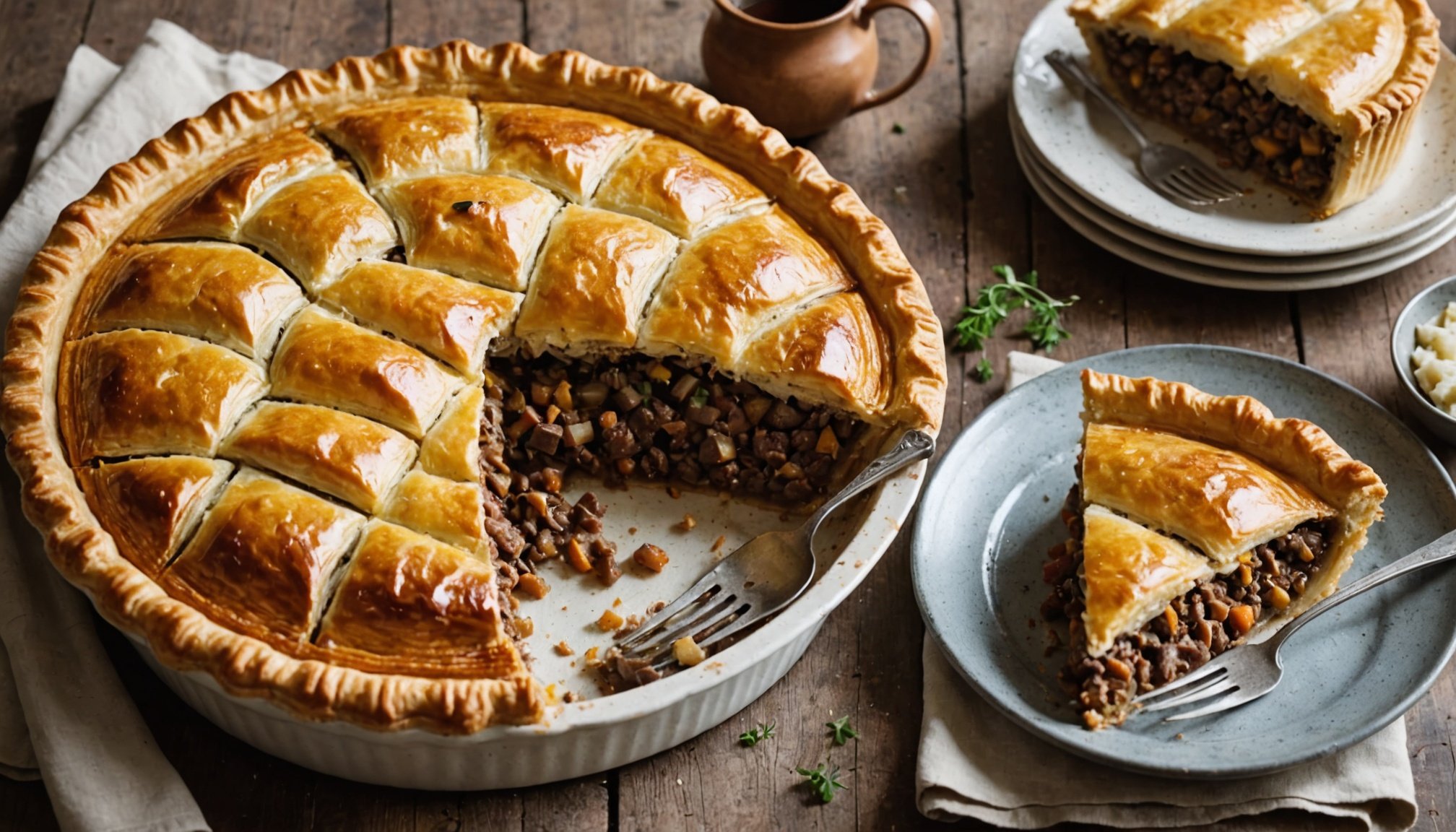Overview of Beef and Onion Pie
Understanding the historical background of beef and onion pie reveals its cultural importance, especially in regions like the UK. This dish has long been a staple, harking back to times when meat pies were crucial for sustenance and convenience. The combination of beef and onions, elegantly wrapped in a tender crust, creates a comforting, hearty meal that has transcended centuries. Part of its enduring appeal lies in its simplicity and robust flavors, both of which offer a taste of heritage with every bite.
Traditional flavors of beef and onion pie are rich and savory, largely attributed to the ingredients’ natural pairings. The onions are often caramelized, adding depth and sweetness, while the beef provides a satisfying heft. Spices and herbs, like thyme or pepper, gently underscore these key elements.
Also to see : Master the Art of Spotted Dick: An Exquisite Recipe with Decadent Custard, Step-by-Step
Comparatively, beef and onion pie holds its ground against other meat pies by maintaining a straightforward approach focused on quality ingredients. Its characteristics—a well-crafted balance of meat, vegetables, and seasoning—differ from more complex pies, such as steak and ale, allowing it to stand out as a beloved comfort food. The charm of beef and onion pie lies in its enduring and familiar flavors.
Ingredients List
A successful beef and onion pie hinges on carefully selected ingredients. The centerpiece is, unsurprisingly, the beef. Opting for a cut with balanced fat content, such as chuck or round, ensures juiciness and robust flavor. Whether diced or minced, letting the beef sit with a touch of salt enhances its natural taste.
Have you seen this : Master Your Cooking with the Best Classic English Pea & Ham Soup Recipe
Onions, the savory counterpart, must be fresh and firm. Yellow onions are typically chosen for their perfect blend of sweetness and bite. Caramelization is key: this process highlights the onion’s natural sugars and injects depth into the filling.
For the crust, simplicity rules. A traditional recipe involves flour, butter, salt, and water. The butter should be cold, diced into the flour to create pockets that translate into flakiness. Feel free to substitute part of the flour with whole wheat for an earthy twist.
Alternatively, consider a shortcrust pastry if aiming for a richer base. Those with dietary restrictions may explore gluten-free flour blends, mindful of maintaining the desired texture.
Balancing these ingredients ensures the pie retains its timeless charm, dancing between hearty and elegant with every mouthful.
Preparing the Filling
Creating the perfect beef and onion filling requires attention to detail, particularly in the steps of chopping and cooking. Begin with the onions, ensuring they are finely chopped to enable even caramelization. The process should gradually turn the onions golden-brown, releasing their natural sweetness. Cook them over medium heat to avoid burning, stirring occasionally for consistency.
Chopping and Cooking Onions
Onions should be peeled and sliced uniformly. A sharp knife is essential for precision, reducing tears and uneven cooking. Caramelization, achieved by cooking slowly, is crucial for depth of flavour, as it enhances the filling’s complexity.
Browning the Beef
For browning the beef, cut the chosen meat into uniform pieces to ensure even cooking. Heat a pan until searing hot and add beef, avoiding overcrowding to prevent steaming. Cook until golden on all sides, sealing in juices and creating a robust layer of flavour.
Combining Ingredients
Combine browned beef with caramelized onions, adjusting seasoning with herbs like thyme or pepper to enrich the taste. Maintaining a balance in seasoning ensures that neither beef nor onions overpower the other. Proper timing and temperature are keys to a cohesive, flavourful filling.
Making the Perfect Golden Crust
Creating a flaky pie crust requires attention to detail and understanding the right ingredients and techniques. Begin with cold butter, which ensures pockets of air within the dough, essential for flakiness. Cut the butter into small cubes and incorporate it with flour, using a pastry cutter or fork until you achieve a coarse, crumbly texture. Gradually add ice-cold water, mixing gently until the dough just holds together.
Resting the dough is a crucial step often overlooked. Allow it to chill in the refrigerator for at least 30 minutes before rolling it out. This process relaxes the gluten, increasing flakiness and ease of handling.
When rolling out the dough, aim for a uniform thickness. Roll from the center outward, turning the dough occasionally to prevent sticking. This consistency is key to an evenly baked crust.
For that perfect golden color, brush the surface with a thin layer of egg wash before baking. This not only enhances visual appeal but also contributes a subtle sheen and additional flavour.
Avoid common pitfalls like overworking the dough and ensure your oven is fully preheated before baking. These steps are vital for achieving a crisp, golden crust that complements the rich filling.
Assembling the Pie
When it comes to assembling the beef and onion pie, precision in layering is crucial. Begin by ensuring the filling is evenly distributed to maintain balance in every bite. Layering techniques include spreading half of the prepared filling across the crust evenly, then slightly compacting it down with the back of a spoon. Cover with the remaining filling, once again ensuring evenness.
Sealing the pie correctly is vital to avoid leakage. After laying the upper crust over the filling, ensure edges are firmly pressed together using a fork or by pinching with your fingers. Crimp the edges to add an attractive finish and enhanced seal.
To ensure the top crust doesn’t collapse or become too dense, create small slits on it. This allows steam to escape, preserving the pie’s texture. Also, before placing the pie in the oven, brush the top with egg wash to encourage a golden, shiny finish.
Accurately following these pie assembly techniques results in a flavorful, well-structured dish that holds its filling intact and delights with every serving. Taking the time to properly assemble the pie ensures a rewarding culinary experience.
Cooking Instructions
Achieving the perfect beef and onion pie requires careful attention to baking conditions. Begin by preheating your oven to an ideal temperature of 200°C (392°F), ensuring an even bake throughout. The pie should typically bake for about 40 to 45 minutes in the center of the oven.
As the pie bakes, watch for a golden brown top, which indicates the crust’s readiness. The filling should be bubbling slightly, confirming that it’s heated thoroughly. If the top seems to brown too quickly, cover it with aluminium foil to prevent overbaking while allowing the inner layers to cook properly.
To create a perfectly crispy bottom crust, place the pie on a preheated baking tray. This added heat conducts directly into the base, enhancing its texture without overcooking the filling.
For the best results, let the pie rest for a few minutes after removing it from the oven. This step allows the filling to settle, providing a cleaner slice and enhanced flavours. By following these precision guidelines, your beef and onion pie will exhibit a balance of textures and rich, savoury notes.
Serving Suggestions
When it comes to serving beef and onion pie, the right accompaniments can enhance the dish’s robust flavors. For a traditional approach, pair with mushy peas, providing a fresh, slightly sweet contrast. Alternatively, roasted or steamed root vegetables such as carrots and parsnips offer a sweet, earthy complement.
Mashed potatoes are a classic choice, contributing creamy texture and mild flavors that balance the savory pie. For added flair, consider topping your mash with a sprinkle of herbs like parsley.
For an engaging presentation, arrange the pie on a platter with colourful seasonal vegetables scattered around. Adding fresh herbs on top can elevate the visual appeal and introduce subtle aromatic notes.
When it comes to beverage pairings, full-bodied red wines such as Shiraz or Cabernet Sauvignon harmonize beautifully with the pie’s hearty flavours, accentuating the depth of the filling. Non-alcoholic options might include a robust herbal tea, like mint or rosemary, to cleanse the palate.
By thoughtfully selecting sides and drinks, you can create a well-rounded, satisfying meal that highlights the comforting nature of beef and onion pie in styles both traditional and modern.
Variations of Beef and Onion Pie
Exploring different variations of beef and onion pie brings exciting possibilities. Adding vegetables such as carrots, peas, or mushrooms can introduce new layers of flavour and texture to the classic dish. These additions not only boost nutritional value but also complement the rich beef and onion combination.
For those seeking to experiment with spices, consider incorporating garlic, chili powder, or even a touch of nutmeg to spice up the pie. Altering the seasoning profile can provide a novel take while still preserving the dish’s comforting essence.
Adapting the recipe for dietary needs, particularly gluten-free options, invites creativity. Opt for gluten-free flour blends in the crust while ensuring texture remains flaky. Meanwhile, integrating non-dairy alternatives like plant-based butter caters to those with lactose intolerance.
Embrace regional inspirations by infusing pies with unique ingredients often found in specific cuisines, such as a hearty red wine reduction to align with French traditions.
These creative twists not only refresh the traditional beef and onion pie experience but can also accommodate diverse palates and preferences, maintaining its place as a beloved comfort food.
Troubleshooting Common Issues
Creating the perfect beef and onion pie is an art that occasionally presents culinary challenges. Soggy crust is a frequent issue, often resolved by ensuring the pie is baked on a preheated baking tray. This step encourages even cooking and a crispy base. Overfilling the crust can also lead to sogginess, so measure filling appropriately.
An overcooked filling can arise from excessive oven time. Keeping an eye on baking progress ensures the filling remains tender and flavorful. Rely on visual cues like bubbling around the edges to gauge readiness rather than strict baking times alone.
Maintaining crust texture over time involves storing leftovers correctly. Allow the pie to cool completely before refrigerating to prevent condensation, which causes sogginess. When reheating, use an oven rather than a microwave to regain crispness.
To store unused pie, wrap portions in aluminium foil or airtight containers, promoting freshness. You might find placing parchment paper between pieces keeps them from becoming mushy.
These strategies help preserve the beef and onion pie’s delightful texture and rich flavours, addressing common pitfalls and enhancing your baking skills.



